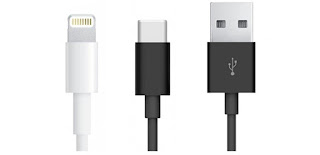Will Apple resist the C-Type USB?
Sometime next year will arrive a new standard for the famous USB cable: the Type C. For the first time since its creation in 1996, the connector will change shape and adopt a much smaller design, fine, and can be plugged in both directions (read: The new USB Connector 3.1 is ready!). A real small revolution that will pose a big problem to Apple, which ends up with a technology very close but not compatible. Indeed, Apple created the Lightning connector two years ago to replace the venerable 30-pin connector on the iPod. Very small and also reversible, the Lightning connector was particularly precursor. But with the arrival of Type C, this proprietary connector will lose its benefits and find itself drowned in the midst of competing systems that should all quickly adopt the new USB standard.
If there was a proof of the enthusiasm of the manufacturers in front of the arrival of the Type C USB, the presentation by Nokia this week of its digital tablet N1 is certainly the best example: the Finnish manufacturer will be the first to adopt the USB connector of Type C. The tablet, which will be marketed during the first quarter of 2015, however, is only equipped with USB 2.0 and not standard 3.1, but the new format was considered more interesting than a Micro-USB connector, despite similar dimensions.
It was in this context that last week stood a summit "Made for IPhone" in Shenzhen, China. Apple has met with a number of manufacturers and sub-contractors who design accessories for IOS devices, in order to inform them about the subtleties of the latest news from the group (e.g. HomeKit or iBeacon) in order to Integration into accessories. During this summit, the Cupertino group discussed the subject of the Lightning connector at length, urging its partners to create audio headphones by being equipped (read: The Lightning helmets will soon arrive), but also to integrate the Lightning connector with Third party products. By opening the possibility for third-party manufacturers to integrate Lightning technology with their products, Apple therefore tries to impose its proprietary format on the maximum before the arrival of Type C in the coming months.
Only, Apple cannot counter the C Type because it is a universal format, and maybe even the first one to actually be. Indeed, the connectors used for the moment on computers and mobile devices such as phones and tablets are different, for reasons of dimensions. But with the arrival of the USB 3.1 Type C, everything will be reflated and all the electronic devices would eventually use the same connector. The implication for Apple is obvious: it will have no choice but to equip its Macs. It should also be noted that Apple laptops will have everything to gain from the arrival of this new standard that will achieve new heights of finesse, and that rumors are considering the arrival of Type C from the next generation of MacBook Air ( READ: Some details on the upcoming MacBook Air?).
Can Apple therefore afford to continue imposing a connector that offers no real advantage when it will soon be using its big competitor in its own products? The answer is of course yes. As Apple knows that the losses caused by the leakage of some users to the competition are far less than the benefits of a closed ecosystem, which allows it to sell millions of accessories and take a commission on each sale of Third-party product operating its licence. If Apple were to separate from its Lightning technology in the coming years, there is a strong bet that it would opt for a more disruptive technology conferring some legitimacy on the use of a proprietary format, such as the charger Magnetic and induction of the Apple Watch. Unless the enactment of a law obliging Apple to use a universal format on its devices (read: New step for the universal Charger), the arrival of the Type C USB on an iPad or an iPhone now seems highly hypothetical.


As always, entertaining and educational.Voice And Data Cabling
ReplyDelete